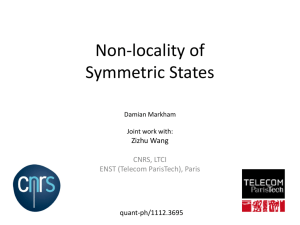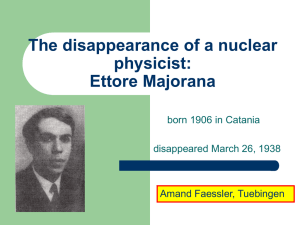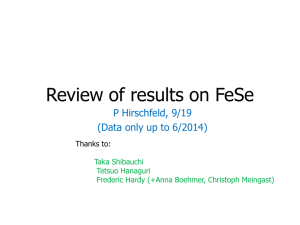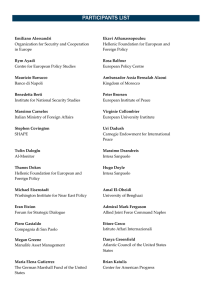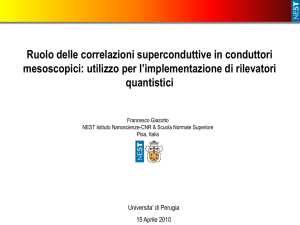What is a Majorana fermion?
advertisement
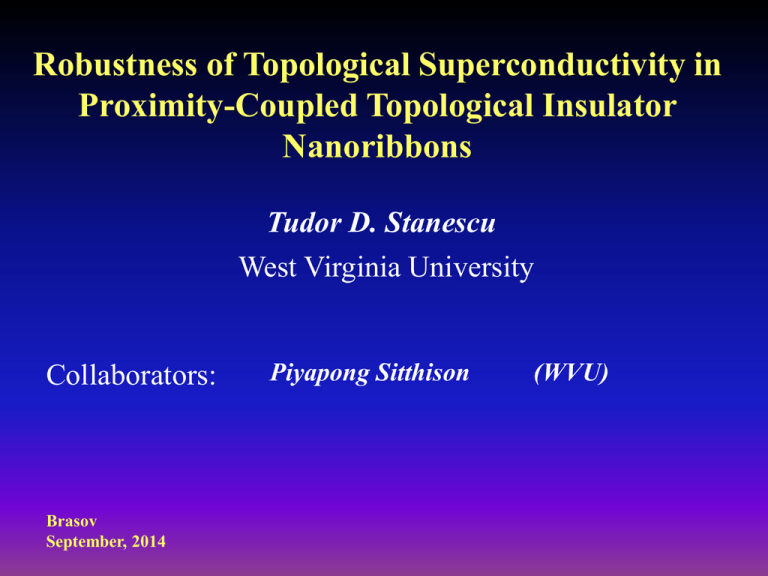
Robustness of Topological Superconductivity in Proximity-Coupled Topological Insulator Nanoribbons Tudor D. Stanescu West Virginia University Collaborators: Brasov September, 2014 Piyapong Sitthison (WVU) Outline Majorana fermions in solid state structures: status and challenges Proximity-coupled topological insulator nanoribbons • Modeling • Low-energy states • Phase diagram • Proximity-induced gap I Majorana fermions in solid state structures What is a Majorana fermion? Question: Are the spinors representing spin-1/2 particles necessarily complex ? Majorana (1937): neutral spin-1/2 particles can be described by a real wave equation: Majorana fermion – an electrically neutral particle which is its own antiparticle Relevance: particle physics (neutrinos ?) Experimental status: NOT observed 2000s: Majorana fermions can emerge as quasiparticle excitations in solid-state systems Superconductors – the natural hosts for Majoranas electron (-e) Cooper pair (-2e) hole (+e) charge is not an observable the elementary excitations are combinations of particles and holes (Bogoliubov quasiparticles) Particle-hole symmetry Zero energy state (Majorana fermion) Spinless fermions + particle-hole symmetry Majoranas at E=0 Practical route to realizing Majorana bound states 1D spinless p-wave superconductor Kitaev, Physics-Uspekhi, 01 Semiconductor nanowire Superconductor Sau et al., PRL’10 Alicea PRB’10 Lutchyn et al., PRL’10 Oreg et al., PRL’10 Single-channel nanowire Spin-orbit coupling Zeeman splitting Proximity-induced superconductivity Probing Majorana bound states: tunneling spectroscopy Sau et al., PRB 82, 214509 (2010) TDS et al., PRB 84, 144522 (2011) Experimental signatures of Majorana physics Mourik et al., Science 336, 1003 (2012) Suppression of the gap-closing signature TDS et al., PRB 84, 144522 (2011) TDS et al., PRL 109, 266402 (2012) Low-energy spectra in the presence of disorder Interface inhomogeneity Static disorder TDS et al., PRB 84, 144522 (2011) Takei et al., PRL 110, 186803 (2013) What is responsible for the selective qp broadening? Proximity effect in a NM-SM-SC hybrid structure TDS et al., PRB 90, 085302 (2014) The soft gap in dI/dV and LDOS TDS et al., PRB 90, 085302 (2014) II Proximity-Coupled Topological Insulator Nanoribbons The topological insulator Majorana wire Cook & Franz, PRB 86, 155431 (2012) Theoretical modeling Low-energy TI states Effective TI Hamiltonian Local potential SC Hamiltonian TI-SC coupling Effective Green function BdG equation Low-energy TI spectrum (3D) Sitthison & TDS, PRB 90, 035313 (2014) Low-energy TI spectrum (2D) Sitthison & TDS, PRB 90, 035313 (2014) Low-energy TI spectrum (1D) V=0; F=0 V=0; F=0.5 V=0.05; F=0.5 Sitthison & TDS, PRB 90, 035313 (2014) Low-energy states V=0; F=0.5 V=0.05; F=0.5 Sitthison & TDS, PRB 90, 035313 (2014) Proximity-induced quasiparticle gap m=0.05 eV m=-0.09 eV Sitthison & TDS, PRB 90, 035313 (2014) Phase diagram Sitthison & TDS, PRB 90, 035313 (2014) Induced qp gap as function of m and F Sitthison & TDS, PRB 90, 035313 (2014) Single interface structures V=0.06 eV V=0 V=0.03 eV Sitthison & TDS, PRB 90, 0000 (2014) Tuning the chemical potential using gates Sitthison & TDS, PRB 90, 0000 (2014) Conclusions Details matter; the unambiguous demonstration of Majorana bound states realistic modelling & controlled exp. conditions TI-SC structures; the realization of robust topological SC phases (and Majorana bound states) over a wide range of m is not a straightforward task Main problem: intrinsic or applied bias potentials may push some of the low-energy states away from the interface Possible solution: symmetric TI-SC structures
